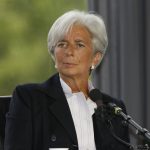China's February Manufacturing Shows Disturbing Economic Trend
 China boasts the second largest economy in the world, but economic research and numbers show a declining Chinese economy in February. And that is not an anomaly, but a disturbing trend.
China boasts the second largest economy in the world, but economic research and numbers show a declining Chinese economy in February. And that is not an anomaly, but a disturbing trend.
Voice of America (VOA) reports:
New figures released Tuesday shows activity in China’s manufacturing sector has fallen to its lowest level in four years, the latest sign of weakness in the world’s second-largest economy.
The official Purchasing Manager’s Index, or PMI, which tracks activity in factories, dropped to 49.0 in February, down from the 49.4 figure posted the month before. Any reading above 50 signals expansion, while a reading below 50 indicates contraction.
You could try to blame these February contraction numbers on the Chinese New Year, which fell on February 8th this year (it is based on a lunar calendar, varying the date between January 21st and February 20th each year) and does slow down, and even shut down, much economic activity, like manufacturing, for a few weeks.
However, PMI falling into contraction levels is not something that only happened during the holiday celebrating months of February and January in China. The next sentence from the VOA article shows China manufacturing contraction to be a very real trend:
It was the seventh straight month of contraction in the official PMI, and the lowest reading since November 2011.
This latest PMI drop at the end of a 7 month contraction trend does not just mean Chinese manufacturing reached its lowest point in months, but its lowest point in years.
Activity in China’s manufacturing sector shrank more sharply than expected in February, surveys showed on Tuesday, prompting smaller companies to shed workers at the fastest pace in seven years…
…
It [the PMI] was the lowest reading since November 2011.
While February’s PMI drop, revealed Tuesday, was more than economists expected, perhaps China’s government was not surprised.
Just Monday, China pumped in money to ease the declining of its economy. A separate Reuters article reported:
China’s central bank resumed its easing cycle on Monday, injecting an estimated $100 billion worth of long-term cash into the economy to cushion the pain from job layoffs and bankruptcies in industries plagued by overcapacity.
Those industries include the steel and coal sectors where China has said it expects to lay off 1.8 million workers.
The People’s Bank of China (PBOC) said on its website it was cutting the reserve requirement ratio, or the amount of cash that banks must hold as reserves, by 50 basis points, taking the ratio to 17 percent for the biggest lenders.
Of course, China’s efforts to fight the economic decline has not evoked the most confidence from economists in the wake of this latest PMI drop. The first above quoted Reuters article captures economists’ response:
“The PMI came in much weaker than markets expected, hinting that recent easing measures have had limited impact in turning around the weakening manufacturing sector,” wrote senior emerging markets economist Zhou Hao at Commerzbank in Singapore.
“We think PBoC will cut policy rates by 25 basis points in the first quarter and lower RRR (banks’ reserve requirement ratio) by another 100-150 basis points this year.”
Bad Global PMI Trend
To add a little extra concern, China is not the only country making headlines for dropping manufacturing numbers in February.
Germany’s PMI took a major hit in February, barely staying above contraction numbers. RTÉ reports:
German manufacturing hardly grew in February with activity falling to its lowest in 15 months, a survey showed today.
Markit’s Purchasing Managers’ Index for manufacturing, which accounts for about a fifth of the economy, plunged to 50.5 in February from 52.3 the previous month.
French manufacturing is also struggling to stay above contraction numbers, but at least showed a slight improvement from the previous month according to the RTÉ article:
French manufacturing activity stagnated in February as the sector struggles to mount a convincing recovery in the face of weak demand.
Markit said its final Purchasing Managers’ Index (PMI) rose to 50.2 in February from 50 in January. That was marginally lower than a preliminary reading of 50.3, but kept the index above the 50-point line dividing expansions in activity from contractions.
This is Money headlines with, “Britain’s economic growth slowest for nearly three years as manufacturing falls ‘towards stagnation’ mark,” reporting:
With exports and order books struggling, Markit posted a balance of 50.8 for February, down from 52.9 in January. This marks the weakest growth seen in the manufacturing sector since April 2013, Markit said.
Makes you wonder how the U.S. performed in February, doesn’t it?
Well, according to Trading Economics:
The final Markit US manufacturing PMI came in at 51.3 in February of 2016, higher than a preliminary reading of 51 but the second-lowest reading since October of 2012. Growth in production volumes slowed to a 28-month low, job growth moderated to a five-month low and producer prices recorded the biggest decline since June of 2012.
That gives the U.S. the highest February PMI of the nations brought up in this blog, but shows a global trend of lower than ideal PMI numbers.
Related Reading:
China Shipbuilding Struggles
Top 10 US Imports from China to Take Advantage of Devalued Yuan (w/ pics)
3 China News Stories Shippers Should Know About
![]()
Source: UC Blog




